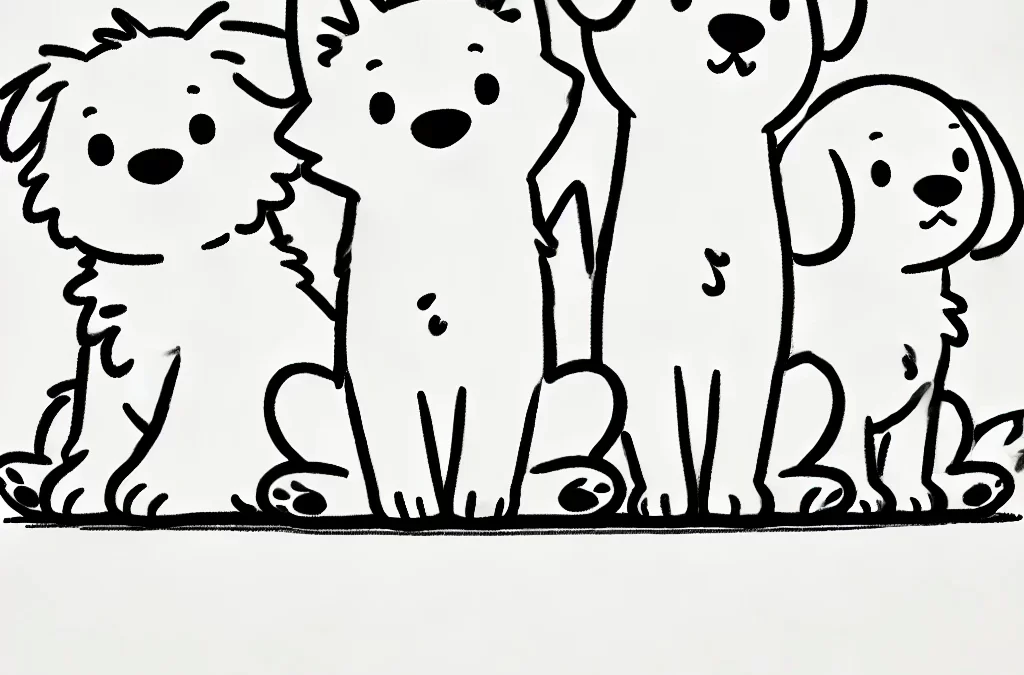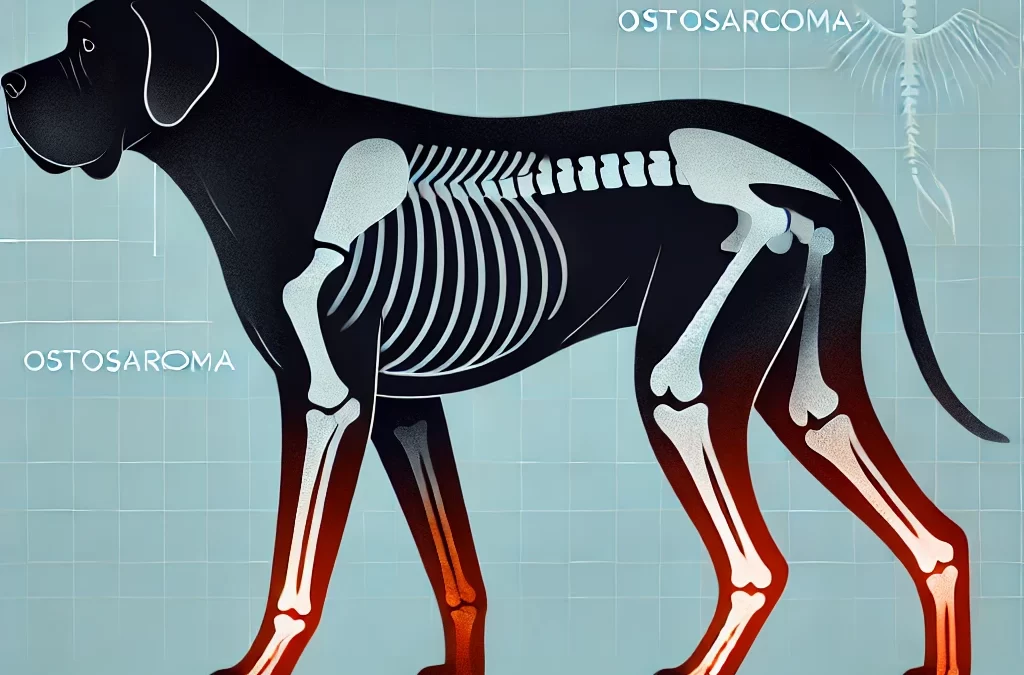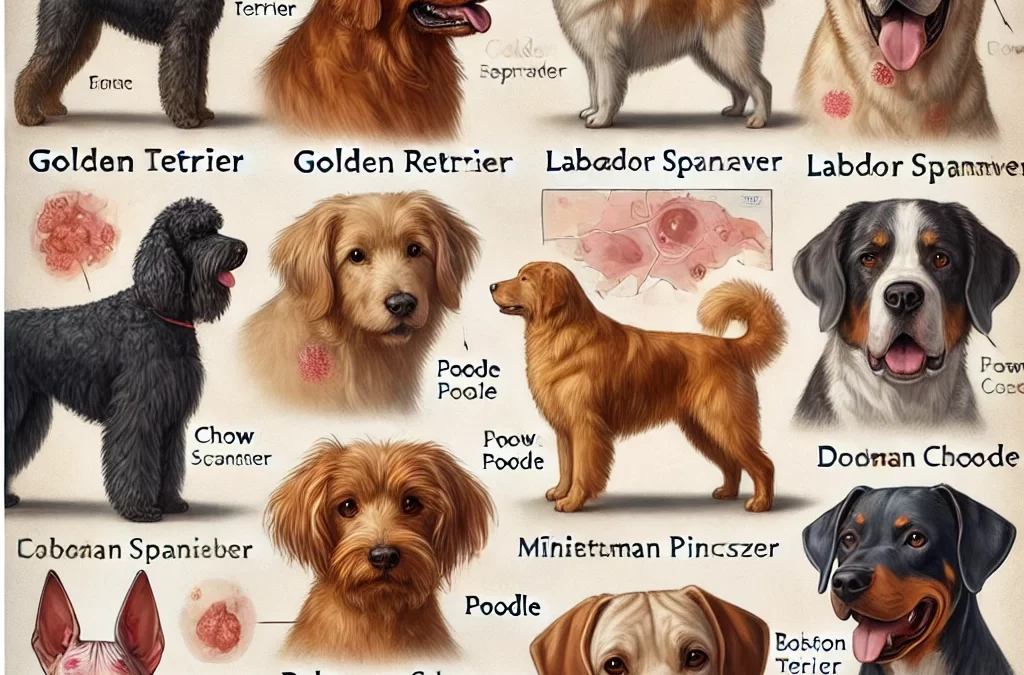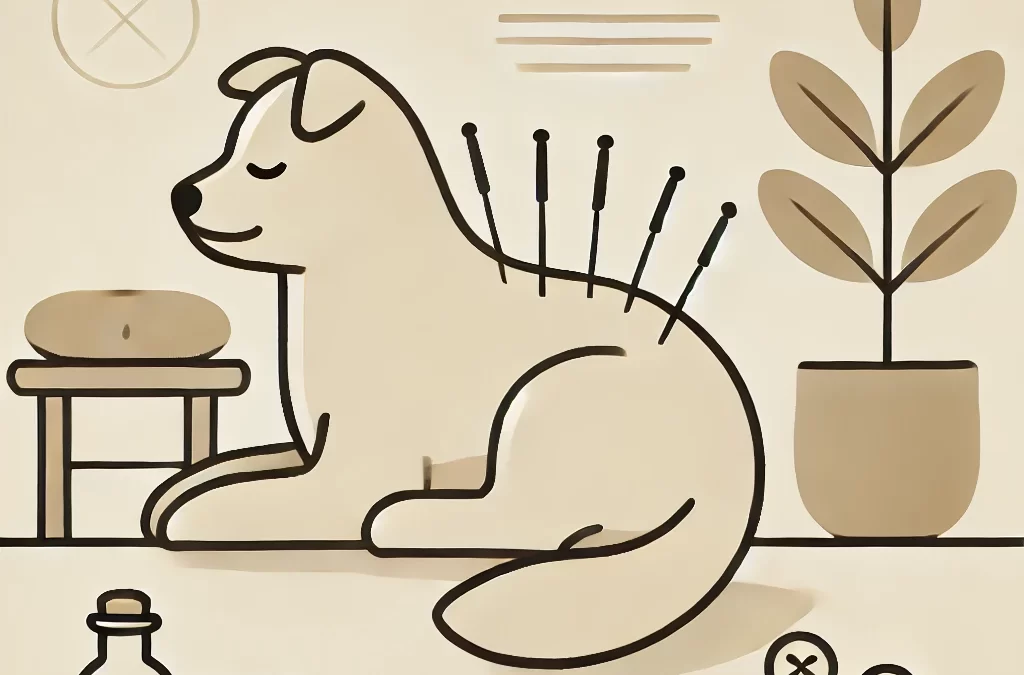
por TCMVET | 6 de febrero de 2025 | Cáncer y tumores en perros
Los tumores del bazo en los perros a menudo se denominan “asesinos silenciosos” porque pueden crecer sin ser detectados durante mucho tiempo, mostrando síntomas mínimos hasta que se convierten en una emergencia médica. Muchos dueños de mascotas solo se dan cuenta de que su perro tiene un tumor en el bazo cuando ocurre una hemorragia interna repentina. Comprender los riesgos, los signos y las opciones de tratamiento para Tumores esplénicos caninos es crucial para la detección e intervención tempranas.
¿Qué son los tumores del bazo en los perros?
El bazo es un órgano importante que ayuda con la filtración de la sangre, la función inmunológica y el reciclaje del hierro. Los tumores en el bazo pueden ser benigno (no canceroso) o maligno (canceroso)Los tipos más comunes de tumores esplénicos en perros incluyen:
- Hemangioma – Un tumor benigno formado por vasos sanguíneos.
- Hemangiosarcoma (HSA) – Un cáncer muy agresivo que se origina en las células de los vasos sanguíneos y tiene un alto riesgo de propagarse a otros órganos.
- Linfoma – Un tipo de cáncer que afecta el sistema linfático y puede comprometer el bazo.
- Hiperplasia nodular esplénica – Una afección no cancerosa en la que el bazo forma nódulos anormales que aún pueden romperse y causar sangrado.
Entre estos, hemangiosarcoma Es el más peligroso y representa un gran porcentaje de los tumores esplénicos. Es particularmente común en razas como Golden Retriever, pastores alemanes y labradores.
Síntomas de tumores del bazo en perros
La detección temprana de tumores del bazo es difícil porque muchos perros permanecen asintomáticos hasta que el tumor crece significativamente o se rompe. Algunos signos a los que hay que prestar atención son:
- Letargo o debilidad – Su perro puede parecer cansado y menos activo de lo habitual.
- encías pálidas – Un signo de anemia, a menudo debido a una hemorragia interna.
- Colapso repentino – Esto puede ocurrir si el tumor se rompe y causa sangrado interno.
- Abdomen agrandado – Un vientre hinchado puede indicar un tumor en crecimiento o una hemorragia interna.
- Pérdida de apetito y pérdida de peso. – Disminución gradual de la ingesta de alimentos y del peso corporal.
- Respiración rápida o aumento de la frecuencia cardíaca. – Un signo de bajo volumen sanguíneo o falta de oxígeno.
Si tu perro muestra cualquiera de estos síntomas, busque atención veterinaria inmediatamente, especialmente si colapsan o tienen encías pálidas.
¿Cómo se diagnostican los tumores del bazo?
Un veterinario normalmente utilizará los siguientes métodos para diagnosticar tumores esplénicos:
- Examen físico – Comprobar si hay abdomen agrandado o signos de anemia.
- Ultrasonido – Ayuda a visualizar masas dentro del bazo.
- Rayos X – Puede presentar agrandamiento del bazo o signos de metástasis.
- Blood Tests – Detecta anemia, recuentos anormales de glóbulos blancos y cambios en el funcionamiento de los órganos.
- Aspiración con aguja fina o biopsia – Ayuda a determinar si el tumor es benigno o maligno.
En muchos casos, El diagnóstico definitivo sólo se puede realizar después de extirpar quirúrgicamente el bazo y examinarlo.
Opciones de tratamiento para los tumores del bazo canino
1. Cirugía (Esplenectomía)
Si se detecta un tumor en el bazo, el tratamiento más común es esplenectomía (extirpación quirúrgica del bazo)Los perros pueden vivir sin bazo, pero si el tumor es maligno, la cirugía por sí sola a menudo no es suficiente para detener la progresión del cáncer.
2. Chemotherapy
Para hemangiosarcoma, se puede recomendar quimioterapia después de la cirugía para frenar la propagación del cáncer. Sin embargo, el pronóstico sigue siendo malo, con un tiempo de supervivencia promedio de 3 a 6 meses Incluso con tratamiento.
3. Apoyo natural y holístico
Algunos dueños de mascotas exploran Terapias naturales Para reforzar el sistema inmunológico y la calidad de vida de su perro. Las posibles opciones incluyen:
- Hongos medicinales (como la cola de pavo y el reishi) – Puede ayudar a reforzar la función inmunológica.
- Hierbas de la medicina tradicional china (MTC) – Algunas mezclas de hierbas, como Baituxiao, se han utilizado para el cuidado de tumores.
- Cambios en la dieta – Una dieta rica en proteínas y antiinflamatoria puede favorecer la salud general.
Si bien estas opciones No puede curar el cáncer, pueden mejorar el bienestar y retardar la progresión de la enfermedad.
¿Se pueden prevenir los tumores del bazo?
Si bien no existe una forma garantizada de prevenir los tumores del bazo, los dueños de mascotas pueden tomar medidas para reducir los riesgos:
- Revisiones veterinarias periódicas – Detección temprana mediante exámenes de rutina y ecografías en razas de alto riesgo.
- Evite la exposición a agentes cancerígenos – Reducir la exposición a pesticidas, humo de segunda mano y alimentos para mascotas de baja calidad.
- Apoya la salud inmunológica – Una dieta equilibrada con antioxidantes puede ayudar a prevenir el daño celular.
Pensamientos finales
Los tumores del bazo en los perros son un problema de salud grave, especialmente hemangiosarcoma, que a menudo pasa desapercibido hasta que se convierte en una amenaza para la vida. Los controles veterinarios regulares, estar atento a los síntomas sutiles y actuar rápidamente si su perro muestra signos de angustia pueden marcar una diferencia fundamental. Si a su perro le diagnostican un tumor esplénico, analice las opciones de tratamiento con su veterinario para determinar el mejor curso de acción para la calidad de vida de su mascota.
Al mantenerse informados y proactivos, los dueños de mascotas pueden brindarles a sus perros el mejor cuidado y apoyo posibles durante estos momentos difíciles.

por TCMVET | 6 de febrero de 2025 | Cáncer y tumores en perros
El cáncer es una preocupación cada vez mayor para los dueños de mascotas, especialmente para aquellos que tienen varios perros. Cuando a un perro de la familia se le diagnostica cáncer, surge una pregunta común: ¿El cáncer canino es contagioso? Comprender la naturaleza del cáncer y cómo se propaga puede ayudar a los dueños de mascotas a tomar las precauciones adecuadas y al mismo tiempo brindar el mejor cuidado a sus compañeros peludos.
¿El cáncer es contagioso en los perros?
La respuesta simple es No—la mayoría de las formas de cáncer en los perros son no contagiosoA diferencia de las enfermedades infecciosas causadas por virus o bacterias, el cáncer es el crecimiento descontrolado de células anormales dentro del cuerpo de un individuo. No se transmite de un perro a otro a través del contacto directo, de compartir comederos o por proximidad.
Sin embargo, hay raras excepciones, como Tumores venéreos transmisibles (TVT), que puede transmitirse por contacto directo, especialmente durante el apareamiento. El TVT es uno de los pocos cánceres transmisibles de origen natural en los perros y afecta principalmente a los perros callejeros o no castrados. Aparte de esto, los cánceres convencionales como el linfoma, el osteosarcoma y los tumores de mastocitos no se pueden transmitir entre perros.
¿Pueden los factores ambientales influir en el cáncer?
Si bien el cáncer en sí no es contagioso, los perros que viven en el mismo hogar pueden compartir riesgos ambientales comunes que podrían contribuir al desarrollo del cáncer. Entre ellos se incluyen:
- Exposición al humo de segunda mano – Los perros que viven en hogares donde hay fumadores tienen un mayor riesgo de desarrollar cáncer de pulmón y tumores nasales.
- Productos químicos tóxicos – Los pesticidas, herbicidas y productos de limpieza del hogar pueden aumentar el riesgo de cáncer en las mascotas.
- Dieta y obesidad – La mala alimentación y la inflamación relacionada con la obesidad pueden contribuir al desarrollo del cáncer con el tiempo.
- Genetics – Si varios perros en un hogar son del mismo linaje o raza, pueden tener una predisposición genética a ciertos tipos de cáncer.
¿Qué deben hacer los dueños de varios perros?
Aunque el cáncer no es contagioso, los dueños de mascotas deben tomar ciertas precauciones para garantizar la salud y el bienestar de todos sus perros:
1. Mantener un ambiente saludable
- Mantenga su hogar libre de toxinas dañinas, incluido el humo del cigarrillo y los productos químicos agresivos.
- Evite usar pesticidas y herbicidas en áreas donde juegan sus perros.
2. Apoya una dieta nutritiva
- Alimente a todos los perros con una dieta equilibrada y de alta calidad con ingredientes frescos y naturales.
- Considere suplementos que apoyen la salud inmunológica, como los ácidos grasos omega-3 y los antioxidantes.
3. Vigile los síntomas en otros perros
- Revise periódicamente si hay bultos, hinchazón, pérdida de peso o cambios de comportamiento.
- Programe controles veterinarios anuales y exámenes de detección de cáncer de rutina, especialmente para perros mayores o razas propensas al cáncer.
4. Proporcionar apoyo emocional
- Si a un perro se le diagnostica cáncer, otros perros del hogar pueden experimentar estrés o cambios de comportamiento.
- Mantenga una rutina estable y brinde comodidad a todas las mascotas del hogar.
5. Consulta a un veterinario
- Si le preocupan los riesgos de cáncer en su hogar, consulte a su veterinario para obtener asesoramiento personalizado sobre prevención y detección temprana.
Conclusión
El cáncer canino no es contagioso, pero los factores ambientales compartidos y las predisposiciones genéticas pueden influir en los riesgos de cáncer en varios perros de una misma casa. Al mantener un hogar saludable, proporcionar una nutrición adecuada y estar atentos a los síntomas, los dueños de mascotas pueden ayudar a sus perros a vivir una vida más larga y saludable. Si a uno de sus perros le diagnostican cáncer, ofrecerle amor, consuelo y atención médica adecuada es la mejor manera de apoyarlo y, al mismo tiempo, garantizar el bienestar de toda la manada.

por TCMVET | 26 de enero de 2025 | Cáncer y tumores en perros
El osteosarcoma (OSA) es el cáncer óseo primario más común en perros y afecta desproporcionadamente a las razas grandes y gigantes. Debido a su naturaleza agresiva y a su rápida metástasis, este cáncer representa un desafío importante para los dueños de mascotas. Sin embargo, comprender los factores de riesgo y adoptar estrategias preventivas puede marcar la diferencia. Este artículo explora por qué los perros grandes son más vulnerables al osteosarcoma y qué medidas proactivas pueden tomar los dueños para minimizar el riesgo.
¿Por qué las razas grandes y gigantes son más susceptibles al osteosarcoma?
- Crecimiento rápido y desarrollo óseo
Los perros de razas grandes y gigantes crecen rápidamente durante sus primeros meses, lo que genera tensión en sus huesos. Este crecimiento rápido puede provocar microdaños en las estructuras óseas, lo que crea una predisposición a mutaciones cancerosas.
- Factores genéticos
Ciertas razas tienen una predisposición genética al osteosarcoma. Las razas más comúnmente afectadas son:- perro danés
- perro de San Bernardo
- Perro lobo irlandés
- rottweiler
- Galgo
- Labrador retriever
- perro perdiguero de oro
- Longitud de las extremidades y estrés óseo
Los perros más altos y con extremidades largas son más propensos a sufrir estrés óseo. El osteosarcoma se presenta con frecuencia en los huesos que soportan peso, como el radio, el cúbito, el húmero y el fémur.
- Influencia hormonal y esterilización/castración
Los estudios sugieren que la esterilización o castración temprana, en particular antes de la madurez ósea, puede aumentar el riesgo de osteosarcoma. Se cree que esto está relacionado con la eliminación de hormonas sexuales, que desempeñan un papel en la regulación del crecimiento óseo.
- Inflamación crónica y traumatismo óseo
Los traumatismos repetidos, las fracturas previas o las cirugías ortopédicas pueden aumentar la susceptibilidad al cáncer en los perros, especialmente en razas ya predispuestas al osteosarcoma.
Cómo reducir el riesgo de osteosarcoma en perros grandes
- Crecimiento controlado durante la etapa de cachorro
- Evite las dietas altas en calorías y de crecimiento rápido que ejercen una presión excesiva sobre los huesos en desarrollo.
- Alimente a los cachorros de razas grandes con alimentos especialmente formulados que promueven un crecimiento constante y controlado.
- Dieta equilibrada con antioxidantes
- Incorporar alimentos ricos en Ácidos grasos omega-3, cúrcuma y antioxidantes para combatir la inflamación y el estrés oxidativo.
- Una dieta con niveles controlados de calcio y fósforo favorece la salud de los huesos sin que se produzca un crecimiento excesivo.
- Esterilización y castración responsable
- Considere retrasar la esterilización hasta que el perro haya alcanzado la madurez esquelética (normalmente alrededor de los 18 a 24 meses para razas grandes).
- Hable sobre opciones alternativas de esterilización con un veterinario para equilibrar el riesgo de cáncer con la salud reproductiva.
- Ejercicio regular sin esfuerzo excesivo
- Las actividades de bajo impacto como la natación y las caminatas controladas ayudan a mantener la salud de los huesos y las articulaciones.
- Evite los saltos excesivos y las actividades repetitivas de alto impacto, especialmente en perros jóvenes.
- Detección temprana y chequeos de rutina
- Los exámenes veterinarios regulares ayudan a detectar cambios óseos sutiles de forma temprana.
- Los propietarios deben estar atentos a señales como: cojera, hinchazón en las extremidades, dolor persistente o dificultad repentina de movimiento.
- Suplementos para fortalecer los huesos
- Glucosamina y condroitina: Apoya la integridad de las articulaciones y los huesos.
- Vitamina D y K2: Ayuda a la absorción de calcio y la densidad ósea.
- Curcumina y hongos medicinales: Exhibe propiedades antiinflamatorias y potencialmente anticancerígenas.
- Evitar toxinas ambientales
- Reducir la exposición a carcinógenos conocidos, incluidos pesticidas, humo de tabaco y alimentos procesados para mascotas con aditivos artificiales.
Pensamientos finales
Si bien los perros de razas grandes y gigantes tienen un mayor riesgo de sufrir osteosarcoma, la atención preventiva puede desempeñar un papel importante en la reducción de esta amenaza. Una dieta bien equilibrada, ejercicio controlado, crianza responsable y control regular de la salud pueden ayudar a los dueños de mascotas a gestionar los riesgos de manera eficaz. Ser proactivo no solo mejora la longevidad de un perro, sino que también mejora su calidad de vida en general. Si nota algún signo de cojera o hinchazón, consulte a un veterinario, ya que el diagnóstico temprano es crucial para mejorar los resultados.

por TCMVET | 26 de enero de 2025 | Cáncer y tumores en perros
El melanoma es uno de los cánceres más preocupantes en los perros y suele aparecer en la boca, la piel, los lechos ungueales e incluso los ojos. Si bien todos los perros pueden desarrollar melanoma, ciertas razas están genéticamente predispuestas debido a su pigmentación, características de la piel y otros factores biológicos. Este artículo explora qué razas de perros son más susceptibles al melanoma, el papel de los factores ambientales y cómo los dueños de mascotas pueden tomar medidas preventivas.
¿Por qué algunas razas son más propensas al melanoma?
El melanoma surge de los melanocitos, las células productoras de pigmento en el cuerpo del perro. Los siguientes factores contribuyen a un mayor riesgo en determinadas razas:
- Predisposición genética – Algunas razas heredan una mayor probabilidad de crecimiento anormal de melanocitos.
- Pigmentación y color del pelaje – Los perros con pigmentación oscura, en particular las razas de pelaje negro, suelen ser más propensos a sufrir melanoma oral. Por el contrario, los perros con pigmentación clara son más susceptibles a sufrir melanoma cutáneo en las zonas expuestas al sol.
- Factores desencadenantes ambientales – La exposición prolongada al sol, el funcionamiento del sistema inmunitario e incluso la dieta pueden influir en el desarrollo del melanoma en los perros.
Razas con mayor riesgo de melanoma
Las investigaciones y los estudios de casos veterinarios sugieren que las siguientes razas tienen un mayor riesgo de desarrollar melanoma:
- Terrier escocés – A menudo se asocia al melanoma de la piel, especialmente en zonas expuestas al sol.
- perro perdiguero de oro – Propensos a diversos tipos de cáncer, incluido el melanoma, especialmente en la boca.
- Labrador retriever – Se han notificado aumentos de casos de melanoma oral.
- Cocker Spaniel – Mayor incidencia de melanoma, especialmente en los ojos (melanoma ocular).
- chow chow – Su pigmentación oscura aumenta la susceptibilidad al melanoma oral.
- Caniche – A los caniches miniatura y estándar se les ha diagnosticado melanoma del lecho ungueal.
- Perro tejonero – Mayor probabilidad de desarrollar melanoma cutáneo debido a factores genéticos.
- Doberman Pinscher – Mayor incidencia de melanomas orales y del lecho ungueal.
- Schnauzer miniatura – Propenso al melanoma tanto cutáneo como oral.
- Boston terrier – Mayor riesgo de melanoma cutáneo, especialmente en personas de color claro.
Factores ambientales y de estilo de vida que aumentan el riesgo
Incluso si un perro no pertenece a una raza de alto riesgo, existen factores externos que pueden influir en el desarrollo del melanoma:
- Exposición al sol – Los perros con piel más clara o pelaje fino corren el riesgo de sufrir melanoma cutáneo inducido por rayos UV.
- Higiene bucal – El cuidado dental deficiente puede contribuir a la inflamación, aumentando potencialmente los riesgos de melanoma oral.
- Edad – Los perros mayores son más propensos a sufrir mutaciones celulares que conducen al melanoma.
- Toxinas y dieta – La exposición a sustancias químicas y la falta de antioxidantes en la dieta de un perro pueden influir en la susceptibilidad al cáncer.
Medidas preventivas para dueños de perros
- Chequeos veterinarios de rutina – La detección temprana es crucial, especialmente en las razas de alto riesgo.
- Exámenes orales y de piel – Revise periódicamente el interior de la boca, las patas y la piel de su perro para detectar crecimientos inusuales.
- Protección solar – Los perros de piel clara deben evitar la exposición excesiva al sol, y un protector solar apto para mascotas puede ayudar.
- Una dieta equilibrada – Los antioxidantes y los ácidos grasos omega-3 pueden apoyar la función inmunológica y reducir la inflamación.
- Mantener la salud bucal – Cepillar los dientes de su perro y proporcionarle masticables dentales puede reducir los riesgos de melanoma oral.
Pensamientos finales
Si bien el melanoma es un cáncer agresivo, conocer los riesgos específicos de cada raza y tomar medidas proactivas puede ayudar a detectarlo y prevenirlo de manera temprana. Los controles regulares, una dieta saludable y un control minucioso pueden marcar una diferencia significativa en la salud de un perro. Si nota algún bulto inusual, especialmente en la boca de su perro, consulte con un veterinario lo antes posible.

por TCMVET | 22 de enero de 2025 | Cáncer y tumores en perros
A medida que los dueños de mascotas buscan alternativas a los tratamientos convencionales contra el cáncer, como la cirugía, la quimioterapia y la radiación, Medicina Tradicional China (MTC) ha surgido como un enfoque complementario prometedor para los perros con tumores. La medicina tradicional china considera el cáncer como un desequilibrio en la energía vital del cuerpo (chi) y tiene como objetivo restablecer la armonía a través de Medicina herbal, acupuntura y terapia dietéticaPero, ¿qué tan efectivo es? ¿Y cómo podemos integrar estos tratamientos en un plan de atención integral del cáncer canino?
Este artículo desafía las opiniones convencionales sobre el tratamiento del cáncer canino al profundizar en los... Sabiduría antigua de la medicina tradicional china, fusionándolo con conocimientos veterinarios modernos para ofrecer Una nueva perspectiva sobre la curación natural.
1. Comprender el cáncer en perros desde una perspectiva de la medicina tradicional china
En la medicina occidental, el cáncer se considera como crecimiento celular descontrolado A menudo se desencadenan por factores genéticos, ambientales o dietéticos. Sin embargo, la medicina tradicional china interpreta los tumores de manera diferente:
- Estancamiento del Qi y la Sangre: Los tumores se forman cuando la energía y la sangre se bloquean, impidiendo una circulación adecuada.
- Acumulación de humedad y flema: El exceso de humedad en el cuerpo puede condensarse en masas.
- Deficiencia de riñón y bazo: El funcionamiento débil de los órganos puede provocar la acumulación de toxinas, lo que reduce la capacidad del cuerpo para eliminar células anormales.
El tratamiento de la MTC se centra en eliminar bloqueos, fortalecer la función de los órganos y aumentar la inmunidad en lugar de simplemente destruir las células cancerosas.
2. Medicina herbaria: un enfoque natural para la reducción de tumores
Las fórmulas herbales chinas para el cáncer tienen como objetivo Reducir los tumores, mejorar la función inmunológica y apoyar la salud de los órganos.Algunas hierbas de uso común incluyen:
- Baituxiao (especie de pez payaso): Conocido por su capacidad para inhibir el crecimiento de tumores, eliminar el calor y desintoxicar el cuerpo.
- Huang Qi (黄芪, astrágalo): Fortalece la inmunidad y mejora el flujo de energía, a menudo se utiliza junto con tratamientos convencionales.
- Ban Zhi Lian (半枝莲, Scutellaria Barbata): Tiene propiedades anticancerígenas y favorece la salud del hígado.
- Ling Zhi (灵芝, Hongo Reishi): Un potente adaptógeno que mejora la respuesta inmune y reduce la inflamación.
- Dang Gui (当归, Angelica Sinensis): Promueve la circulación sanguínea y previene el estancamiento del Qi, comúnmente utilizado para tumores que afectan la piel o los músculos.
Estas hierbas a menudo se recetan en fórmulas adaptadas a las necesidades de cada perro. Constitución específica y tipo de tumor, haciendo imprescindible el trato personalizado.
3. Acupuntura: Manejo del dolor y activación de la curación
La acupuntura se utiliza ampliamente en pacientes humanos con cáncer para aliviar el dolor y mejorar el bienestar, y los mismos principios se aplican a los perros. Esta práctica funciona estimulando puntos meridianos específicos, cual:
- Reducir la inflamación y el dolor.
- Aumenta la circulación para ayudar a reducir los tumores.
- Apoyar el sistema inmunológico para retardar la progresión del cáncer.
- Mejora la digestión y los niveles de energía en perros debilitados.
Las sesiones de acupuntura son no invasivo y la mayoría de los perros lo toleran bien. Muchos dueños de mascotas notan mejoras en el comportamiento de sus perros. movilidad, comodidad y apetito Después del tratamiento.
4. Terapia dietética: curación a través de la alimentación
La comida es medicina en la medicina tradicional china y los ajustes dietéticos juegan un papel fundamental en apoyando a perros con cáncerEl objetivo es Reduce la inflamación, nutre el Qi y previene el crecimiento de tumores. A través de una nutrición equilibrada.
Alimentos recomendados:
- Proteínas magras:Se prefieren el pato, el conejo y el pescado a la carne roja, que puede ser inflamatoria.
- Verduras antiinflamatorias:Zanahorias, brócoli y hongos como el shiitake y el maitake.
- Granos saludables:Mijo, quinua y cebada, que fortalecen el sistema digestivo.
- Caldo de huesos:Apoya la digestión y aporta minerales esenciales.
Alimentos que se deben evitar:
- Alimentos procesados con aditivos artificiales
- Exceso de alimentos grasosos o aceitosos, que contribuyen a la humedad.
- Golosinas azucaradas, ya que se cree que el azúcar Alimentar el crecimiento del tumor
Una dieta cuidadosamente diseñada, combinada con hierbas y acupuntura, puede Ayuda a mantener los niveles de energía y mejora la resistencia general del perro. Contra el cáncer.
5. Integración de la medicina tradicional china con los tratamientos convencionales
Si bien la medicina tradicional china ofrece herramientas poderosas para el manejo de tumores caninos, funciona mejor cuando Combinado con atención veterinaria occidentalMuchos veterinarios ahora adoptan un enfoque integrador, utilizando la medicina tradicional china junto con cirugía, radiación o quimioterapia para:
- Reducir los efectos secundarios de los tratamientos convencionales
- Fortalecer el organismo del perro contra la recurrencia del cáncer
- Mejora la comodidad general y la longevidad.
6. Cuándo considerar la medicina tradicional china para un perro con cáncer
La medicina tradicional china es especialmente beneficiosa cuando:
- La cirugía no es una opción debido a la ubicación del tumor o la edad del perro.
- El perro experimenta efectos secundarios graves por la quimioterapia o la radiación.
- El objetivo es cuidados paliativos prolongar la calidad de vida en lugar de curar el cáncer.
Dado que cada perro responde de manera diferente, trabajar con un Veterinario formado en medicina tradicional china garantiza un plan de tratamiento seguro y eficaz.
Un futuro holístico para el tratamiento del cáncer canino
La medicina tradicional china proporciona una Suave pero poderoso Enfoque para el tratamiento de tumores caninos abordando la causa principal en lugar de sólo los síntomas. Al incorporar Medicina herbal, acupuntura y terapia dietéticaLos dueños de mascotas pueden mejorar el bienestar de su perro y ofrecer un camino compasivo y natural hacia la curación.
El tratamiento del cáncer no debe centrarse únicamente en prolongar la vida, sino también en Mejorando la calidad de cada díaCon el equilibrio adecuado de La medicina tradicional china y la medicina occidental, los perros pueden disfrutar Un viaje más cómodo y satisfactorio, incluso ante un diagnóstico de cáncer.





